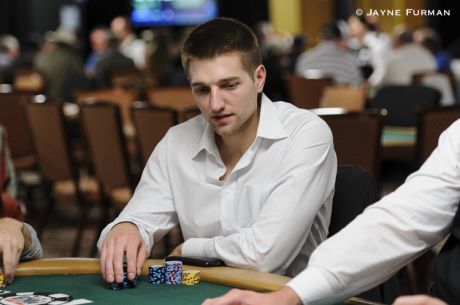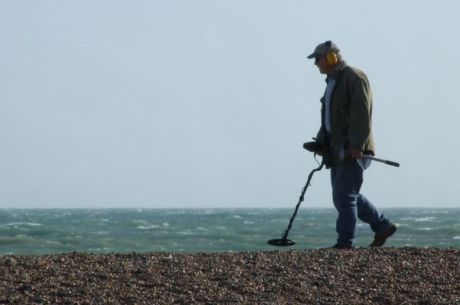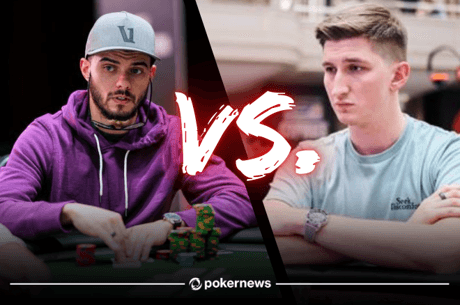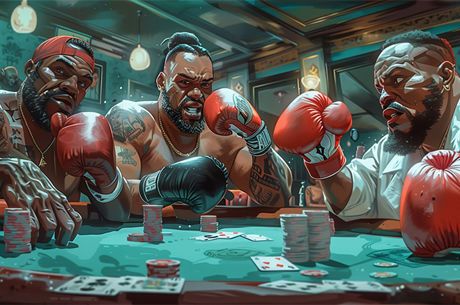A New Game: Final Table Decisions in The Bigger $162, Part 1

As in other emerging fields of inquiry, no-limit hold’em’s current puberty is fraught with surprises. A nice source for such surprises is exploring the convoluted maze of adjustments mandated by final table pay jumps in a large field tournament.
Last weekend I found myself at the final table of The Bigger $162 on PokerStars. Final table play is almost a new game when compared to what comes before. Knowing something about the “Independent Chip Model” (ICM), I think I avoided some mistakes many comparably skilled (or unskilled, if you prefer) NLHE players would make.
Despite having this understanding, I still managed to make many three-figure errors, and arguably a couple of four-figure ones. These were decisions I had considered close at the time, but in fact weren’t.
In this two-part article we’ll look at a couple of those decisions in some detail, hopefully both preparing us for similar spots, but also generally improving the prescriptions of our ICM-tinted glasses.
Hand #1: No Play to Be Made
We are five-handed with exactly 17 big blinds (BB). Here is the layout of stacks…
Under the Gun (UTG): 31 BB
Hero (CO): 17 BB
Button (BTN): 15.5 BB
Small Blind (SB): 31 BB
Big Blind (BB): 56 BB
… and here are the payouts still in play:
1st: $39,723
2nd: $29,051
3rd: $21,936
4th: $16,126
5th: $11,620
The UTG player who is loose and aggressive raises the minimum to 2 BB and in the cutoff we look down at 6x6x. The BTN short stack is a strong player. The BB is a good regular, but overly tight. The SB is also loose and the weakest player at the table.
We can rule out calling. For one, it gives us no chance at winning the pot immediately. There are also players behind who can reopen the action. On top of that, I believed the raiser to be opening quite a variety of hands, as perhaps the player should, and calling invites UTG to bask in three cards of equity with hands like 10x9x-offsuit. This is equity I can seize for myself with a reraise.
Hope, Reality, and Dread
First let me present the hopeful scenario for my moving all-in. This involved the UTG player first raising a whopping 38% of hands and (should it fold back around) calling 8.4% of hands facing my shove. This assumes UTG will fold Ax10x and KxQx, but call with 5x5x+ and AxJx+. If all these parameters are the case, and with rightly tight all-in ranges from the three players behind, I am losing $200 by moving all in here. So, best-case scenario, $200 is up in flames.
Now let’s look at a realistic scenario: the first player opens a still loose 30% of hands and calls my shove with Ax10x+, KxQx, and 5x5x+. That’s 10.5% of hands. ICMizer (an ICM calculator) reveals that in this scenario I am lighting $540 on fire by shoving. In fact, the threshold for my moving in is AxQx-offsuit or better and 10x10x and higher pairs. Not even 9x9x is a shove (!) and it is not a shove still if we take out the 12 combinations of Ax10x-offsuit from the UTG player’s calling range.
This all seems incredibly tight given the fact that we are sitting far below the average stack, and further still from the chip lead. In two hands, when we are in the big blind, we’ll be on par with the shortest stack, if all other things remain quiet.
And it gets worse, for what it is worth. It is no strain on the imagination that the UTG player would open with AxXx-suited, Ax8x-offsuit or better, 10x9x-suited, 9x8x-suited, 3x3x and better pairs, Kx10x-offsuit or better, QxJx-offsuit, and any two suited Broadway cards. That still reads like a wide range, although it is but 21% of hands. In this case, I am setting $1,100 on fire.
Order Matters
Let’s exchange positions with the big blind and look at the same decision facing a min-raise and looking down at pocket sixes. In that case, if we were to shove our two sixes — we should probably be flat-calling but that point aside — the -$1,100, -$540, and -$200 scenarios upgrade to -$363, +$281, and +$500, respectively. Why is this change so dramatic?
When we fold from the cutoff, not only do we avoid the chance someone behind wakes up with a premium, top 5% holding, but we invite the chance for three other players to get involved in an elimination scenario, which would move us up $4,500 in guaranteed money instantly and more than that in the expected value of our stack.
Even though neither scenario — that is, KxKx waking up behind our shove, or two players entering a mortal conflict — occurs particularly frequently, that frequency is still non-zero, and so affects the ICM calculations when comparing the decisions. Someone gets dealt 10x10x or a better pair and AxQx+ 5% of the time.
So What, Then?
We should fold our two sixes here. But alas, I shoved.
We’ve established moving all in and calling both to be in error. There is the option of three-betting to 4.5 big blinds, heretofore undiscussed. If we want to have a range of hands with which to make this play — and I am not saying we should — 6x6x is not in the list of candidates. QxJx or something similarly playable postflop, with blockers to four-bet all-ins, is far preferable, in terms of hands that would be folding to an all-in. And then of course there is AxAx.
But I didn’t have aces this hand, and it was kings that woke up directly behind me on the button. And that money I theoretically lit on fire became all too real.
These spots are counterintuitive, complicated, and worth the math. In Part Two we’ll back up to look at a more complicated spot from this final table which deserves some extended analysis.
Gareth Chantler is a professional poker player who encourages you to check out the interviews, videos, promotions, and strategy articles at the Full Tilt Blog.
Get all the latest PokerNews updates on your social media outlets. Follow us on Twitter and find us on both Facebook and Google+!








